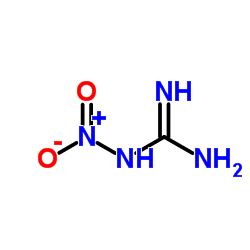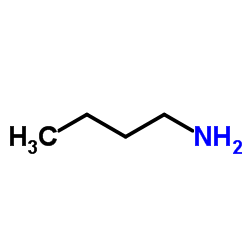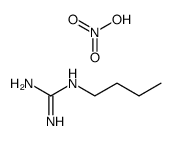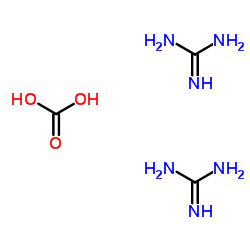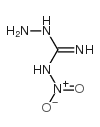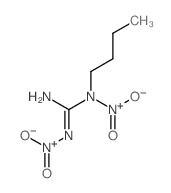5458-83-3
| 英文名 | 2-butyl-1-nitroguanidine |
|---|---|
| 英文别名 |
3-Nitro-1-n-butyl-guanidin
N-Butyl-N'-nitroguanidine 1-Butyl-3-nitroguanidine Guanidine,N-butyl-N'-nitro 1-(n-Butyl)-3-nitroguanidin |
| 密度 | 1.29g/cm3 |
|---|---|
| 沸点 | 283.8ºC at 760mmHg |
| 分子式 | C5H12N4O2 |
| 分子量 | 160.17400 |
| 闪点 | 125.5ºC |
| 精确质量 | 160.09600 |
| PSA | 93.73000 |
| LogP | 1.49690 |
|
Section1. IDENTIFICATION OF THE SUBSTANCE/MIXTURE Product identifiers Product name: 1-Butyl-3-nitroguanidine CAS-No.: 5458-83-3 Relevant identified uses of the substance or mixture and uses advised against Identified uses: Laboratory chemicals, Manufacture of substances Section2. HAZARDS IDENTIFICATION Classification of the substance or mixture Classification according to Regulation (EC) No 1272/2008 [EU-GHS/CLP] Flammable solids (Category 2) Acute toxicity, Oral (Category 3) Skin irritation (Category 2) Eye irritation (Category 2) Specific target organ toxicity - single exposure (Category 3) Classification according to EU Directives 67/548/EEC or 1999/45/EC Highly flammable. Toxic if swallowed. Irritating to eyes, respiratory system and skin. Label elements Labelling according Regulation (EC) No 1272/2008 [CLP] Pictogram Signal wordDanger Hazard statement(s) H228Flammable solid. H301Toxic if swallowed. H315Causes skin irritation. H319Causes serious eye irritation. H335May cause respiratory irritation. Precautionary statement(s) P210Keep away from heat/sparks/open flames/hot surfaces. - No smoking. P261Avoid breathing dust/ fume/ gas/ mist/ vapours/ spray. P301 + P310IF SWALLOWED: Immediately call a POISON CENTER or doctor/ physician. P305 + P351 + P338IF IN EYES: Rinse cautiously with water for several minutes. Remove contact lenses, if present and easy to do. Continue rinsing. Supplemental Hazardnone Statements According to European Directive 67/548/EEC as amended. Hazard symbol(s) R-phrase(s) R11Highly flammable. R25Toxic if swallowed. R36/37/38Irritating to eyes, respiratory system and skin. S-phrase(s) S16Keep away from sources of ignition - No smoking. S26In case of contact with eyes, rinse immediately with plenty of water and seek medical advice. S36/37/39Wear suitable protective clothing, gloves and eye/face protection. S45In case of accident or if you feel unwell, seek medical advice immediately (show the label where possible). Other hazards - none Section3. COMPOSITION/INFORMATION ON INGREDIENTS Substances Formula: C5H12N4O2 Molecular Weight: 160,17 g/mol ComponentConcentration 1-Butyl-3-nitroguanidine CAS-No.5458-83-3- Section4. FIRST AID MEASURES Description of first aid measures General advice Consult a physician. Show this safety data sheet to the doctor in attendance. If inhaled If breathed in, move person into fresh air. If not breathing, give artificial respiration. Consult a physician. In case of skin contact Wash off with soap and plenty of water. Take victim immediately to hospital. Consult a physician. In case of eye contact Rinse thoroughly with plenty of water for at least 15 minutes and consult a physician. If swallowed Do NOT induce vomiting. Never give anything by mouth to an unconscious person. Rinse mouth with water. Consult a physician. Most important symptoms and effects, both acute and delayed To the best of our knowledge, the chemical, physical, and toxicological properties have not been thoroughly investigated. Indication of any immediate medical attention and special treatment needed no data available Section5. FIREFIGHTING MEASURES Extinguishing media Suitable extinguishing media Use water spray, alcohol-resistant foam, dry chemical or carbon dioxide. Special hazards arising from the substance or mixture Carbon oxides, nitrogen oxides (NOx) Advice for firefighters Wear self contained breathing apparatus for fire fighting if necessary. Further information Use water spray to cool unopened containers. Section6. ACCIDENTAL RELEASE MEASURES Personal precautions, protective equipment and emergency procedures Wear respiratory protection. Avoid dust formation. Avoid breathing vapors, mist or gas. Ensure adequate ventilation. Remove all sources of ignition. Evacuate personnel to safe areas. Avoid breathing dust. Environmental precautions Prevent further leakage or spillage if safe to do so. Do not let product enter drains. Methods and materials for containment and cleaning up Sweep up and shovel. Contain spillage, and then collect with an electrically protected vacuum cleaner or by wet-brushing and place in container for disposal according to local regulations (see section 13). Keep in suitable, closed containers for disposal. Contain spillage, pick up with an electrically protected vacuum cleaner or by wet-brushing and transfer to a container for disposal according to local regulations (see section 13). Reference to other sections For disposal see section 13. Section7. HANDLING AND STORAGE Precautions for safe handling Avoid contact with skin and eyes. Avoid formation of dust and aerosols. Provide appropriate exhaust ventilation at places where dust is formed.Keep away from sources of ignition - No smoking.Take measures to prevent the build up of electrostatic charge. Conditions for safe storage, including any incompatibilities Store in cool place. Keep container tightly closed in a dry and well-ventilated place. Specific end uses no data available Section8. EXPOSURE CONTROLS/PERSONAL PROTECTION Control parameters Components with workplace control parameters Exposure controls Appropriate engineering controls Avoid contact with skin, eyes and clothing. Wash hands before breaks and immediately after handling the product. Personal protective equipment Eye/face protection Face shield and safety glasses Use equipment for eye protection tested and approved under appropriate government standards such as NIOSH (US) or EN 166(EU). Skin protection Handle with gloves. Gloves must be inspected prior to use. Use proper glove removal technique (without touching glove's outer surface) to avoid skin contact with this product. Dispose of contaminated gloves after use in accordance with applicable laws and good laboratory practices. Wash and dry hands. The selected protective gloves have to satisfy the specifications of EU Directive 89/686/EEC and the standard EN 374 derived from it. Body Protection Complete suit protecting against chemicals, Flame retardant antistatic protective clothing, The type of protective equipment must be selected according to the concentration and amount of the dangerous substance at the specific workplace. Respiratory protection Where risk assessment shows air-purifying respirators are appropriate use a full-face particle respirator type N100 (US) or type P3 (EN 143) respirator cartridges as a backup to engineering controls. If the respirator is the sole means of protection, use a full-face supplied air respirator. Use respirators and components tested and approved under appropriate government standards such as NIOSH (US) or CEN (EU). Section9. PHYSICAL AND CHEMICAL PROPERTIES Information on basic physical and chemical properties a) AppearanceForm: solid b) Odourno data available c) Odour Thresholdno data available d) pHno data available e) Melting point/freezingMelting point/range: 83 - 86 °C point f) Initial boiling point and no data available boiling range g) Flash pointno data available h) Evaporation rateno data available i) Flammability (solid, gas) The substance or mixture is a flammable solid with the category 2. j) Upper/lowerno data available flammability or explosive limits k) Vapour pressureno data available l) Vapour densityno data available m) Relative densityno data available n) Water solubilityno data available o) Partition coefficient: n- no data available octanol/water p) Autoignitionno data available temperature q) Decompositionno data available temperature r) Viscosityno data available s) Explosive propertiesno data available t) Oxidizing propertiesno data available Other safety information no data available Section10. STABILITY AND REACTIVITY Reactivity no data available Chemical stability no data available Possibility of hazardous reactions no data available Conditions to avoid Heat, flames and sparks. Extremes of temperature and direct sunlight. Incompatible materials Strong oxidizing agents, Strong bases Hazardous decomposition products Other decomposition products - no data available Section11. TOXICOLOGICAL INFORMATION Information on toxicological effects Acute toxicity no data available Skin corrosion/irritation no data available Serious eye damage/eye irritation no data available Respiratory or skin sensitization no data available Germ cell mutagenicity no data available Carcinogenicity IARC:No component of this product present at levels greater than or equal to 0.1% is identified as probable, possible or confirmed human carcinogen by IARC. Reproductive toxicity no data available Specific target organ toxicity - single exposure Inhalation - May cause respiratory irritation. Specific target organ toxicity - repeated exposure no data available Aspiration hazard no data available Potential health effects Inhalation May be harmful if inhaled. Causes respiratory tract irritation. IngestionToxic if swallowed. SkinMay be harmful if absorbed through skin. Causes skin irritation. EyesCauses serious eye irritation. Signs and Symptoms of Exposure To the best of our knowledge, the chemical, physical, and toxicological properties have not been thoroughly investigated. Additional Information RTECS: Not available Section12. ECOLOGICAL INFORMATION Toxicity no data available Persistence and degradability no data available Bioaccumulative potential no data available Mobility in soil no data available Results of PBT and vPvB assessment no data available Other adverse effects no data available Section13. DISPOSAL CONSIDERATIONS Waste treatment methods Product Burn in a chemical incinerator equipped with an afterburner and scrubber but exert extra care in igniting as this material is highly flammable. Offer surplus and non-recyclable solutions to a licensed disposal company. Contact a licensed professional waste disposal service to dispose of this material. Contaminated packaging Dispose of as unused product. Section14. TRANSPORT INFORMATION UN number ADR/RID: 2930IMDG: 2930IATA: 2930 UN proper shipping name ADR/RID: TOXIC SOLID, FLAMMABLE, ORGANIC, N.O.S. (1-Butyl-3-nitroguanidine) IMDG: TOXIC SOLID, FLAMMABLE, ORGANIC, N.O.S. (1-Butyl-3-nitroguanidine) IATA:Toxic solid, flammable, organic, n.o.s. (1-Butyl-3-nitroguanidine) Transport hazard class(es) ADR/RID: 6.1 (4.1)IMDG: 6.1 (4.1)IATA: 6.1 (4.1) Packaging group ADR/RID: IIIMDG: IIIATA: II Environmental hazards ADR/RID: noIMDG Marine pollutant: noIATA: no Special precautions for user no data available SECTION 15 - REGULATORY INFORMATION N/A SECTION 16 - ADDITIONAL INFORMATION N/A |
| 海关编码 | 2925290090 |
|---|
|
~% 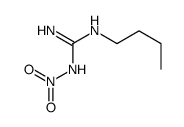
5458-83-3 |
| 文献:Davis; Luce Journal of the American Chemical Society, 1927 , vol. 49, p. 2304 Full Text Show Details Davis; Abrams Pr.am.Acad.Arts Sci., vol. 61, p. 450 Chem. Zentralbl., 1927 , vol. 98, # I p. 2295 |
|
~% 
5458-83-3 |
| 文献:McKay; Wright Journal of the American Chemical Society, 1947 , vol. 69, p. 3029 |
|
~% 
5458-83-3 |
| 文献:Davis; Elderfield Journal of the American Chemical Society, 1933 , vol. 55, p. 737 |
|
~% 
5458-83-3 |
| 文献:Fishbein; Gallaghan Journal of the American Chemical Society, 1954 , vol. 76, p. 1877 |
|
~% 
5458-83-3 |
| 文献:McKay; Wright Journal of the American Chemical Society, 1947 , vol. 69, p. 3029 Full Text Show Details McKay Journal of the American Chemical Society, 1949 , vol. 71, p. 1968 |
| 上游产品 6 | |
|---|---|
| 下游产品 8 | |
| 海关编码 | 2925290090 |
|---|---|
| 中文概述 | 2925290090 其他亚胺及其衍生物,以及它们的盐。监管条件:无。增值税率:17.0%。退税率:9.0%。最惠国关税:6.5%。普通关税:30.0% |
| 申报要素 | 品名, 成分含量, 用途 |
| Summary | 2925290090 other imines and their derivatives; salts thereof。Supervision conditions:None。VAT:17.0%。Tax rebate rate:9.0%。MFN tariff:6.5%。General tariff:30.0% |

